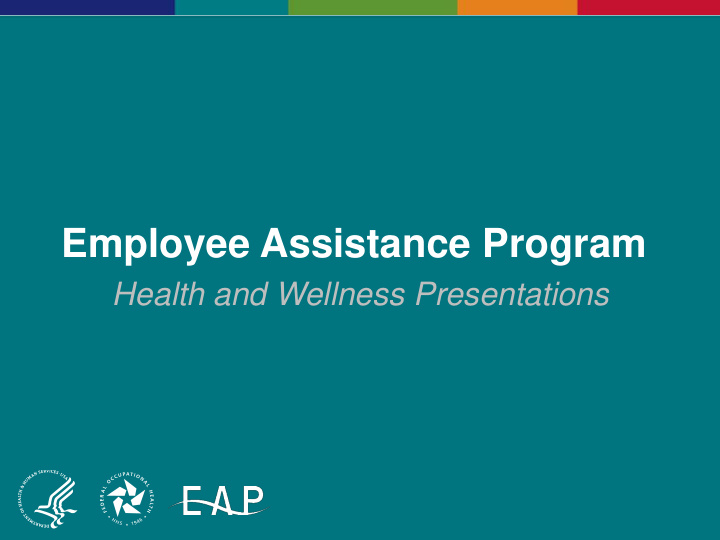



Employee Assistance Program Health and Wellness Presentations
Employee Assistance Program CIVILITY IN THE WORKPLACE
Objectives − Define civility in the workplace − Identify behaviors and changes needed to create a civil workplace − Review skills and techniques needed to build and create civility in the workplace
Disrespectful Behavior in the Workplace − Actions that show disregard of others or violate workplace norms for respect − Personal attacks, rudeness and aggressive behaviors • Name-calling • Bullying • Stereotyping • Discounting a person’s ideas and views
Top Ten Terrible Behaviors Civility Initiative Survey, The Johns Hopkins University and the Jacob France Institute of the University of Baltimore, 2007 1. Discrimination in an employment situation 2. Erratic or aggressive driving that endangers others 3. Taking credit for someone else's work 4. Treating service providers as inferiors 5. Jokes or remarks that mock another's race, gender, age, disability, sexual preference or religion 6. Children behaving aggressively or bullying others 7. Littering (including trash, spitting, pet waste) 8. Misuse of handicapped privileges 9. Smoking in non-smoking places or smoking in front of non-smokers without asking 10. Using cell phones or text messaging in mid-conversation or during an appointment or meeting
Defining Civility in the Workplace − Johns Hopkins Civility Project founded in 1997, led by Dr. P.M. Forni: The JHCP is an aggregation of academic and community outreach activities, that aims to assess the significance of civility, manners and politeness in contemporary society − Dr. Forni’s 2002 definition: “Being civil means being constantly aware of others and weaving restraint, respect and consideration into the very fabric of this awareness.” − Baltimore Workplace Civility Study (2003) used the definition “behaviors that help to preserve the norms for mutual respect; civility reflects concerns for others” (L. Andersson)
History of Civility − Every Action done in Company, ought to be with Some Sign of Respect, to those that are Present. − Sleep not when others Speak, Sit not when others stand, Speak not when you Should hold your Peace, walk not on when others Stop. − Show not yourself glad at the Misfortune of another though he were your enemy. − Use no Reproachful Language against any one neither Curse nor Revile. − Shake not the head, Feet, or Legs roll not the Eyes lift not one eyebrow higher than the other wry not the mouth, and bedew no mans face with your Spittle, by approaching too near him when you Speak. Washington, George.(1971) Rules of Civility & Decent Behavior in Company and Conversation: a Book of Etiquette. Williamsburg, VA: Beaver Press. Available online at: http://www.history.org/Almanack/life/manners/rules2.cfm
Creating A Civil Workplace − Policies and Procedures − Managers − Staff
Creating a Civil Workplace: Policies and Procedures − Workplace Violence Policy − Courtesy Policy − EEO Process − Alternative Dispute/Collaborative Resolution (Mediation) − Employee Assistance Program (EAP) − Others particular to your agency?
Creating a Civil Workplace: Managers and Supervisors − Modeling — setting the tone − Monitoring — assuring expectations of civility are met in the office and agency − Mediating — intervening when conduct is not appropriately civil or when conflict occurs
Creating a Civil Workplace: Staff − Awareness of what is required/expected in a civil workplace − Self-awareness of how we communicate and behave − Role modeling civil communication and behavior − Collaborating with peers/management to promote civility
Civil Behaviors: Concrete Actions 1. Respect others 2. Think positively 3. Pay attention 4. Make a difference 5. Speak kindly 6. Say thank you 7. Accept others 8. Rediscover silence 9. Listen 10. Keep your cool Gulf Coast Foundation: Because It Matters initiative, 2007-2010, http://www.gulfcoastcf.org/news/agenda/
Civil Communication: Giving Feedback − Be clear, concrete, and specific − Be descriptive and use behavioral examples − Focus on what can be changed (e.g., a style rather than a personal characteristic) − Include positive feedback − Take responsibility for your opinion: Use “I” statements − The person initiating the feedback sets a tone of respect and in so doing can contribute to another’s receptivity and a civil dialogue
Civil Communication: Receiving Feedback − What’s my experience and sensitivity level with regard to being evaluated in the workplace? − What’s my history of responding to criticism? − What do I value in myself regardless of what others may say about me? − Will I be able to hear positive feedback, or am I defensive from the start? − What can I do to prepare myself to be open to criticism; is there anything I can learn from the feedback given? − Can this be an opportunity for civil dialogue?
A Civil Society − Respectful engagement with others can reduce the stress we experience in the workplace − Organizations, managers and employees all have a part to play − By actively seeking self-awareness, and observing the golden rule, we can collaborate to create a truly civil society
Federal Occupational Health’s Employee Assistance Program (EAP) Help Available All Day, Every Day We Care, Just Call (800) 222-0364 (888) 262-7848 (TTY) www.FOH4You.com
17
Recommend
More recommend